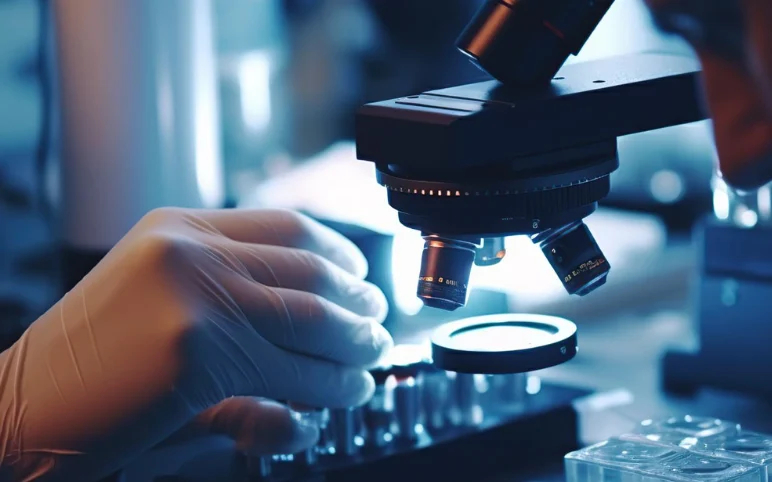4WEB Medical Launched its Cervical Spine Plating Solution
On August 15, 2023, 4WEB Medical, an orthopedic implant company focused on developing innovative implants that utilize its proprietary Truss Implant Technology™, launched the newest addition to the company’s implant portfolio, the Cervical Spine Plating Solution (CSTS-PS).
The company also intends to increase the cervical product offering in early Q4 with an integrated anchor fixation system and a stand-alone integrated plate in addition to the cervical plate launch. Both devices will provide surgeons with a range of cervical fusion construct alternatives, enhancing the currently offered stand-alone cervical offering. With this portfolio enlargement and ongoing product development, 4WEB solidifies its position as a market leader for cervical interbody fusion.
Geoff Bigos, Vice President of 4WEB’s spine division, commented, “By adding the Cervical Spine Plating Solution to 4WEB’s existing interbody device offering, the company continues to demonstrate its commitment to investing in further development of a comprehensive cervical portfolio.”
“The launch of the Cervical Spine Plating Solution is a significant milestone for 4WEB. The company’s cervical portfolio is currently 4WEB’s fastest growing product line and with the addition of cervical plating, anchor fixation, and integrated plates, 4WEB will continue its rapid growth trajectory in 2023 and beyond,” said Jessee Hunt, President of 4WEB Medical.
As per DelveInsight’s “Spinal Surgery Devices Market” report, the global spinal surgery devices market is estimated to grow at a CAGR of 5.65% during the forecast period from 2023 to 2028. The spinal surgery devices market is observing remarkable market growth owing to various factors such as the subsequent rise in spinal disorders across the globe, increasing road accidents, and increasing demand for minimally invasive surgical procedures among others. Further, the increasing demand for technologically advanced spinal surgery devices in the market will also spur market growth in the forthcoming years. Additionally, a rise in spending on spinal surgery products along with the increasing product launches and approvals, and other factors will create a requisite for the spinal surgery devices in the market. Therefore, the market for spinal surgery devices is estimated to grow at a substantial CAGR during the forecast period from 2023 to 2028.
Viseon Launched Visualization System for Minimally Invasive Spine Surgery
On August 15, 2023, Viseon Inc. announced the US commercial rollout and initial clinical use of the First-of-its-Kind 4K Advanced Visualization System for Minimally Invasive Spine Surgery.
The Viseon MaxView 4K System is a cutting-edge, towerless, sophisticated visualization system that is most useful in an ambulatory surgical center scenario and requires no capital equipment expense or operating room footprint.
A real 4K experience on a 4K Operating Room monitor is made possible by the 4K System, which consists of a single-use sterile 4K imaging camera and a reusable, non-sterile 4K Image Control Box. As a 4K Digital Platform, the device also can record real-time surgical videos while still images are being taken, giving the surgeon the ability to create a digital content database for teaching, presentations, publications, patient case reviews, and further analysis using cutting-edge machine learning and AI algorithms to optimize patient outcomes.
“Enabling advanced minimally invasive spine surgery procedures to be performed in a more safe, efficient and economic manner benefits the patient, the surgeon, and the hospital,” said Jeffrey Valko, Viseon Chief Executive Officer. Jeffrey further added, “Visualization seems to be such a fundamental requirement during spine surgery but advancing minimally invasive techniques require more advanced visualization that significantly benefits patient’s safety without a large economic burden on the hospital. Viseon uniquely enables this with the first-ever MaxView 4K System. We are fortunate to have an exceptionally talented product development team who have repeatably demonstrated their ability to rapidly innovate next-generation patented technology enabling us to expand into additional markets such as Neurosurgery, ENT, Endoscopy, and other Orthopedic uses.”
According to DelveInsight’s “Image-Guided Surgery Devices Market” report, the global image-guided surgery devices market was valued at USD 5,540.87 million in 2022, growing at a CAGR of 5.81% during the forecast period from 2023 to 2028 to reach USD 7,765.22 million by 2028. The image-guided surgery devices market is observing remarkable market growth due to the factors such as the escalating burden of the geriatric population prone to chronic diseases, and the rising prevalence of chronic diseases such as cardiovascular, cancers, neurological, and others across the globe. Further, a gradual increase in approval of image-guided surgery devices, rapid technological advancement in the products, increasing demand for minimally invasive surgeries, and others will create a necessity for image-guided surgery devices in the market. Therefore, the market for image-guided surgery devices is estimated to grow at a substantial CAGR during the forecast period from 2023 to 2028.
ZimVie Announced FDA Approval for New Mobi-C® Implant
On August 10, 2023, ZimVie Inc., a global life sciences leader in the dental and spine markets, received the U.S. Food and Drug Administration approval for the smaller height of the Mobi-C® Cervical Disc in seven footprints that will address the anatomical needs of the US patient population.
Mobi-C is a mobile-bearing prosthesis made of cobalt-chromium alloy and polyethylene that may be implanted in a single step without the need for vertebral anchors such as screws or keels or bone chiseling. The Mobi-C Cervical Disc Prosthesis is recommended for skeletally mature patients with intractable radiculopathy (arm pain and/or neurological deficit) with or without neck pain or myelopathy caused by an abnormality localized to the level of the disc space and at least one of the following conditions as determined by radiographic imaging (CT, MRI, or X-rays): herniated nucleus pulposus, spondylosis, and/or visible loss of disc height compared to adjacent levels.
The Mobi-C Cervical Disc Prosthesis is implanted using an anterior approach. Patients should have failed at least six weeks of conservative treatment or demonstrated progressive signs or symptoms despite non-operative treatment before implantation of the Mobi-C Cervical Disc Prosthesis.
“The 4.5mm height implants are an important addition to the Mobi-C lineup,” said Jad G. Khalil, M.D., orthopedic spine surgeon at Michigan Orthopaedic Surgeons, PLLC. He further added “Surgeons will be able to use the prostheses in more significantly collapsed discs and avoid over-distraction of the facet joints. This will expand the indications for cervical disc arthroplasty and therefore more patients can benefit from the clinically compelling Mobi-C Cervical disc.”
Kee D. Kim, M.D., Professor and Chief of Spinal Neurosurgery at the University of California, Davis underscores the clinical importance of the approval, added, “Improper sizing of an artificial disc can lead to problems such as prosthesis migration, subsidence, and segmental kyphosis. We also found from our biomechanical study that increasing the height of an artificial disc by just 1mm reduced the range of motion at that level by around 50%. Even a 5mm height artificial disc may be too tight for some patients. Therefore, FDA approval of 4.5mm height Mobi-C disc is very good news for our patients and allows greater flexibility for the surgeons to choose the best fitting artificial disc.”
“The approval of the 4.5mm Mobi-C is a win for our surgeons and their patients, as well as a validation of thoughtful strategy by our global Regulatory Affairs team who utilized real-world clinical evidence gained from EU studies to show long-term safety and efficacy and secure the FDA approval for the smaller disc,” said Rebecca Whitney, Global President of ZimVie Spine. Rebecca Whitney added, “We are pleased to provide surgeons the largest range of footprint and height options in the market to bring motion preservation to their patients. We will commercialize the product in the US this fall.”
According to DelveInsight’s “Artificial Disc Market” report, the global artificial disc market was valued at USD 1.59 billion in 2022, growing at a CAGR of 11.16% during the forecast period from 2023 to 2028 to reach USD 3.01 billion by 2028. The artificial disc market is slated for positive market growth owing to factors such as the increasing geriatric population, rising prevalence of degenerative disc disorders, growing number of trauma cases & sports-related injuries, and increasing product development activities, among other factors.
GE HealthCare Received FDA Clearance for Portrait Mobile, A First-Of-Its-Kind, Wireless Monitoring Solution Aiding Early Detection of Patient Deterioration
On August 14, 2023, GE HealthCare, received 510(k) clearance from the United States Food and Drug Administration (FDA) for its Portrait Mobile wireless and wearable monitoring solution.
The Portrait Mobile platform enables real-time continuous monitoring with a personalized view of the patient’s vitals while keeping patients mobile during critical recovery periods, especially after surgery or discharge from the intensive care unit.
Clinical professionals can detect deterioration earlier by continuously monitoring patients and seeing data in real-time compared with conventional spot-check approaches, which normally take place only every 4-6 hours. By removing all traditional tethers and enabling patients to wander freely across the ward, the wireless patient-worn sensors and the smartphone-sized monitor can improve outcomes and shorten hospital stays.
To modernize respiration rate monitoring with cutting-edge wireless sensor technology, Portrait Mobile leverages GE HealthCare’s track record in parameter perfection. Dual-vector respiration rate measuring technology, which is a key component of the system, makes use of a cutting-edge algorithm created specifically for mobile patients. It improves continuous respiratory rate detection through optimized electrode placement, even with varying breathing patterns.
Unrecognized patient decline, especially after surgery, can have dangerous but avoidable effects, with 30-day mortality following surgery ranking as the third-leading cause of death globally. Healthcare professionals can identify patient deterioration as it occurs and take prompt action before a patient deteriorates because of the constant flow of data and measurement of vital indicators including respiration rate, oxygen saturation, and pulse rate.
“Patients recovering from major surgery are fragile. Most patients currently have vital signs monitored every 4-6 hours. We have shown that vital sign abnormalities are common – and sometimes profound and prolonged,” said Dr. Daniel Sessler, Michael Cudahy Professor and Chair of Outcomes Research at Cleveland Clinic, as well as the Principal Investigator for a joint trial currently evaluating Portrait Mobile. Dr. Daniel also added “Many potentially serious episodes of instability are missed with intermittent vital sign assessments. Continuous vital sign monitoring might help clinicians identify patients who are having difficulty so they can provide help quickly.”
“It’s important for recovery that patients be able to move around freely while their vital signs are being monitored,” said Neal Sandy, general manager, of monitoring solutions, at GE HealthCare. Neal Sandy further added, “Until Portrait Mobile, patient monitoring required that patients be tethered to their beds, limiting mobility. GE HealthCare designed Portrait Mobile with this need in mind – the advent of a small wearable, wireless inpatient monitoring solution that provides reliable monitoring to the patient’s care team, while allowing for more patient freedom and flexibility during recovery, is an important advancement in acute care.”
According to DelveInsight’s “Patient Monitoring Devices Market” report, the global patient monitoring devices market was valued at USD 35.21 billion in 2022, growing at a CAGR of 8.20% during the forecast period from 2023 to 2028, to reach USD 56.46 billion by 2028. The escalating demand for patient monitoring devices is primarily attributed to the increase in the prevalence of various chronic and lifestyle-associated disorders. Moreover, the sudden outbreak of the COVID-19 pandemic has also contributed to the patient monitoring devices market. Additionally, the growing preferences for remote patient monitoring systems among the patient and healthcare providers, the increase in technological advancement in the product arena, and the rise in the approval of various patient monitoring devices in the current year, among others are also some of the factors responsible for potentially increasing the global patient monitoring devices market during the forecast period (2023-2028).
CytoSorbents Completed US and Canadian STAR-T Pivotal Trial
On August 14, 2023, CytoSorbents Corporation, a leader in the treatment of life-threatening conditions in intensive care and cardiac surgery using blood purification via its proprietary polymer adsorption technology, announced that it completed the pivotal STAR-T (Safe and Timely Antithrombotic Removal – Ticagrelor) randomized, controlled trial, following the last scheduled patient follow-up.
The STAR-T trial is evaluating the ability of DrugSorb®-ATR to reduce perioperative bleeding due to the widely-used blood thinner, ticagrelor (Brilinta®, AstraZeneca) in patients undergoing cardiothoracic surgery.
The goal of using DrugSorb-ATR is to allow patients to get the critical surgery they need without delay while reducing or preventing this bleeding risk by actively removing the drug from blood during the surgery when installed in the heart-lung machine.
DrugSorb-ATR had received FDA Breakthrough Device Designation for this indication. The STAR-T pivotal study was conducted by many leading cardiothoracic surgery centers in North America and is intended to support U.S. FDA and Health Canada marketing approval for DrugSorb-ATR in this application.
Dr. Efthymios N. Deliargyris, Chief Medical Officer of CytoSorbents stated, “We are very pleased to complete all patient-related procedures in the STAR-T trial without a single study subject lost to follow-up. This is another critical step of the process delivered on time and with 100% success. We are focused on ensuring complete and high-quality study data collection, ultimately leading to database lock and triggering the statistical analyses that will provide the readouts of the trial. We continue to expect topline results by the end of the year.”
According to DelveInsight’s “Blood Purification Devices Market” report, the global blood purification devices market was valued at USD 4.90 billion in 2022, growing at a CAGR of 4.19% during the forecast period from 2023 to 2028, to reach USD 6.27 billion by 2028. The demand for blood purification devices is primarily witnessing growth on account of the increase in the number of Chronic Kidney diseases (CKD) and End Stage Renal Disease (ESRD) patients, the surge in the cases of hypertension and diabetes leading to kidney disorders, technological advancements in hemodialysis, increasing product approvals, and increase in adoption of blood purification equipment.
Acorai Received Breakthrough Device Designation for Non-Invasive Intracardiac Pressure Monitor
On August 10, 2023, Acorai, a start-up medical device manufacturer from Sweden, announced that the U.S. Food and Drug Administration (FDA) granted Breakthrough Device Designation for Acorai’s Heart Monitor, a device for the non-invasive estimation of diastolic pulmonary artery pressure (dPAP), systolic pulmonary artery pressure (sPAP), and mean pulmonary artery pressure (mPAP) in patients with Stage C Heart Failure who have been referred for hemodynamic monitoring.
Acorai is creating a proprietary machine learning system, first-of-its-kind hardware technology, and non-invasive intracardiac pressure monitoring (IPCM) device. For licensed healthcare professionals (HCPs), the gadget is meant to be a companion test. It is intended to be used in a hospital or clinical context in addition to standard-of-care assessment to detect hemodynamic congestion and enable individualized heart failure treatment.
Preliminary results of 281 patients from their 400-patient Swedish pilot research, showed a significant connection to the invasive gold-standard assessments of pulmonary pressure.
Acorai’s CEO and Co-Founder Filip Peters said, “We could not be more delighted with the decision from the FDA, and it constitutes a huge milestone for us as a company. Congratulations to the entire Acorai team who have worked hard to enable this.”
Kasper Bourdette, Chief Operating Officer and Co-Founder added, “Receiving breakthrough designation is a massive inflection point in our device development journey, and we are thrilled for the decision. This provides further signaling that we are on the right path and motivation for the [Acorai] team to take the device to approval in the coming few months.”
Jakob Gelberg, Chief Technology Officer and Co-Founder commented, “From ideation to assembling such a talented group of individuals in our team, we are convinced that we have what it takes to bring our device to the patients who need it the most. Regular reviews by the FDA in this development stage are crucial to ensuring we can meet the challenges ahead”.
According to DelveInsight’s “Blood Pressure Monitoring Devices Market” report, the global blood pressure monitoring devices market was valued at USD 1.04 billion in 2022, growing at a CAGR of 10.68% during the forecast period from 2023 to 2028 to reach USD 2.10 billion by 2028. The blood pressure monitoring devices market is witnessing positive growth owing to various factors such as the increasing prevalence of hypertension, the surge in the geriatric population, the increasing prevalence of cardiovascular disease, and technological advancements in product offerings. Therefore, the market for blood pressure monitoring devices is estimated to grow during the forecast period from 2023 to 2028.



